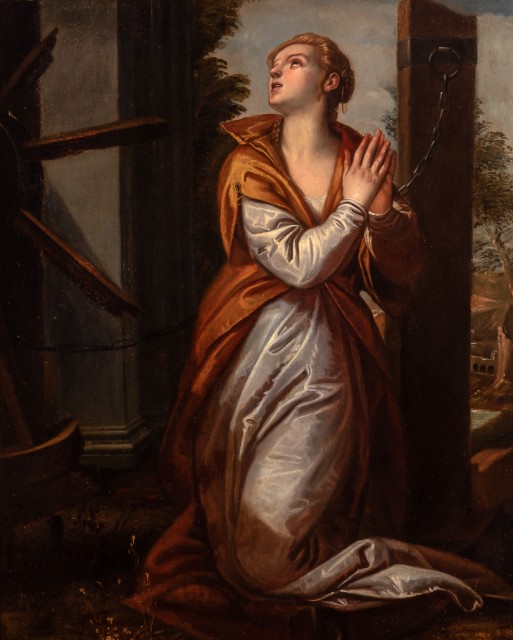St. Catherine & the Wheel
10/19/2020 Old Master Paintings

NEW YORK, NY -- Catherine of Alexandria was one of the most beloved of Christian saints from the early Middle Ages well into the present day. According to her legend, she was a beautiful and learned Christian noblewoman who lived in Roman Egypt in the early 4th century CE. She was such a brilliant speaker that she handily defeated a group of pagan philosophers in a public debate, which so incensed the local magistrates that they condemned her to death. The means chosen for her execution was a monstrous machine incorporating a huge spiked wheel. However, rather than killing her, the device broke apart and released her. The outraged authorities subsequently had her beheaded.
During the late Middle Ages and early Renaissance, Catherine was portrayed as a Mediaeval princess, lavishly dressed, wearing a coronet, and holding a fragment of a spiked wheel, usually in quiet conversation with other saints. Starting in the mid-16th century, however, artists began to focus on the episode of her botched execution. The potential drama of this scene was almost irresistible. Some painters showed the wheel spinning wildly and exploding in all directions, from which the firework known as a “Catherine wheel” takes its name.
Another moment from that same episode can be seen in a painting by a Venetian artist of the late 16th or early 17th century. Here Catherine is portrayed after the machine has broken apart, kneeling alone in prayer on a wooded hilltop, with the city of Alexandria in the distance. Her would-be executioners are nowhere to be seen; all that remains of their attempt to destroy her are the broken spokes of the wheel and a large timber detached from the engine standing upright behind her. This is an unusual treatment of Catherine’s story: an instant taken out of time, reminiscent of Gothic depictions of Christ meditating before his crucifixion.
The same moment in the story was presented very differently by the 17th-century Venetian artist Giulio Carpioni, in a graceful ink drawing, Saint Catherine Rescued from the Wheel. Here Catherine is again shown kneeling in prayer among the fragments of the machine -- which, in its explosive breakup, has taken no fewer than seven of her executioners with it. Their bodies are strewn about in the rubble, as one lone survivor runs away in terror. Hovering above the scene are several angels, one brandishing a club, which he has presumably just used to smash the horrific engine.
St. Catherine is often shown in the company of other saints, and especially with the Holy Family. An example of this subject is The Holy Family with Saint Catherine and Two Angels, attributed to the 16th-century Italian artist Orazio Samacchini. The setting is a landscape at evening, probably during the family’s flight to Egypt to escape the soldiers of King Herod. The family seems to have made a shelter for the night by throwing a blanket over the lower branches of a tree. In attendance are two small angels, who have brought some exotic fruit for their supper. Catherine, in her most elegant princely dress and coronet, kneels devoutly among them, leaning on a fragment of the spiked wheel.
Why is she here? Her legend tells us that Catherine had a vision in which she was mystically married to the Christ child, but there is no sign of that event here. She was herself an Egyptian, so perhaps she has come to guide the family -- from four centuries in the future -- to their refuge in her homeland. Most likely, however, she represents the donor who commissioned this painting, whose patron saint Catherine may well have been. Her presence here would thus be an expression of that donor’s desire to be close to profound and transcendent holiness.
Old Master Paintings & Drawings
The October 28, 2020 auction of Old Master Paintings & Drawings offers three depictions of St. Catherine of Alexandria from the Collection of Donald and Leona Kuba, lot 39, lot 56 and lot 65.